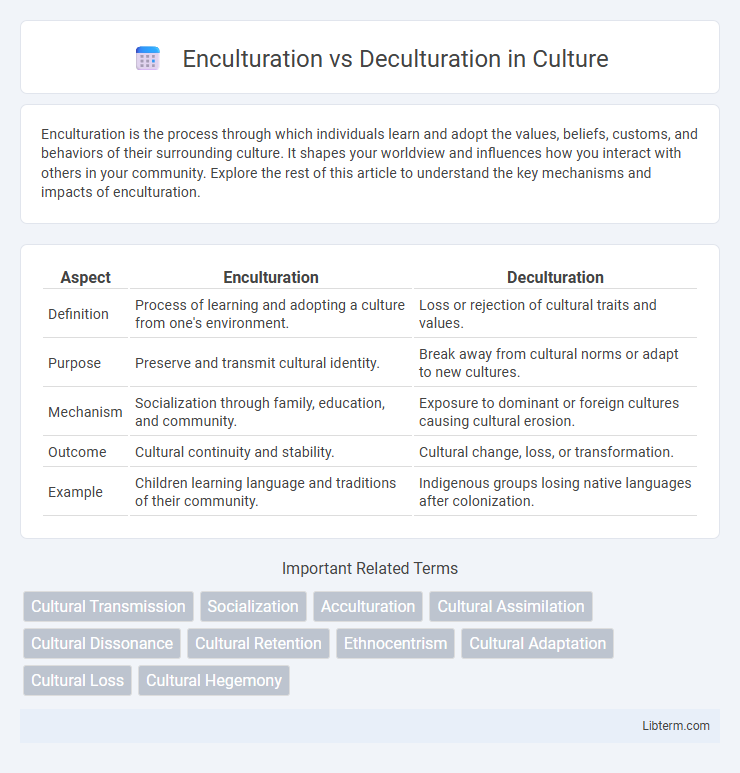Enculturation is the process through which individuals learn and adopt the values, beliefs, customs, and behaviors of their surrounding culture. It shapes your worldview and influences how you interact with others in your community. Explore the rest of this article to understand the key mechanisms and impacts of enculturation.
Table of Comparison
| Aspect | Enculturation | Deculturation |
|---|---|---|
| Definition | Process of learning and adopting a culture from one's environment. | Loss or rejection of cultural traits and values. |
| Purpose | Preserve and transmit cultural identity. | Break away from cultural norms or adapt to new cultures. |
| Mechanism | Socialization through family, education, and community. | Exposure to dominant or foreign cultures causing cultural erosion. |
| Outcome | Cultural continuity and stability. | Cultural change, loss, or transformation. |
| Example | Children learning language and traditions of their community. | Indigenous groups losing native languages after colonization. |
Introduction to Enculturation and Deculturation
Enculturation is the process by which individuals learn and adopt the values, customs, and behaviors of their surrounding culture, often beginning in early childhood through family, education, and social interactions. Deculturation occurs when individuals lose or abandon their original cultural identity, typically due to prolonged exposure to a different dominant culture or forced assimilation. Understanding both processes is crucial for studying cultural adaptation, identity formation, and the dynamics of cultural change within societies.
Defining Enculturation: Shaping Cultural Identity
Enculturation is the lifelong process through which individuals acquire the values, beliefs, language, and customs of their native culture, shaping their cultural identity and social behavior. This process begins in early childhood within the family and community, allowing individuals to internalize norms and traditions that define their cultural group. Understanding enculturation provides insight into how cultural continuity is maintained and how individuals develop a sense of belonging within their society.
Understanding Deculturation: Loss and Change in Culture
Deculturation refers to the process where individuals or groups lose aspects of their original culture due to external influences or dominant cultures, resulting in significant cultural change and identity shifts. It often occurs in contexts like colonization, migration, or globalization, where traditional customs, language, and values diminish over time. Understanding deculturation is essential for recognizing the dynamics of cultural erosion and the challenges communities face in preserving their heritage amidst modern pressures.
Historical Perspectives on Cultural Transformation
Enculturation involves the historical process by which individuals absorb and internalize the values, customs, and norms of their culture, often through family, education, and social institutions. Deculturation represents the loss or displacement of cultural elements due to factors such as colonization, migration, or globalization, leading to a transformation or erosion of traditional cultural identities. Historical perspectives highlight that cultural transformation is frequently marked by the tension between preserving heritage through enculturation and adapting to external influences resulting in deculturation.
Key Differences Between Enculturation and Deculturation
Enculturation refers to the process by which individuals learn and adopt the values, customs, and norms of their native culture, establishing cultural identity from birth. Deculturation involves the loss or rejection of cultural traits, often due to external influences like colonization, migration, or assimilation into a dominant culture. Key differences include enculturation's role in cultural continuity and identity formation, whereas deculturation leads to cultural change or erosion through disconnection from original cultural practices.
Agents of Enculturation in Society
Agents of enculturation in society include family, educational institutions, peers, and media, each playing a critical role in transmitting cultural norms, values, and beliefs from one generation to the next. Family serves as the primary agent, instilling foundational language and customs, while schools reinforce societal expectations and knowledge through formal education. Peer groups and media influence social behaviors and perceptions, shaping individual identity within the broader cultural context and countering the effects of deculturation, which involves the loss or abandonment of cultural traits.
Causes and Drivers of Deculturation
Deculturation occurs primarily due to external pressures such as colonization, globalization, and forced assimilation policies that erode native cultural practices and languages. Economic dependency and urbanization also drive deculturation by disrupting traditional lifestyles and social structures. These factors collectively displace indigenous knowledge and weaken cultural identity, leading to gradual cultural loss.
Impacts on Individual and Collective Identity
Enculturation strengthens individual and collective identity by embedding cultural norms, values, and practices that foster a sense of belonging and continuity within a community. Deculturation disrupts this process, leading to identity confusion, loss of cultural heritage, and weakened social cohesion as individuals and groups lose touch with foundational cultural elements. The tension between enculturation and deculturation significantly shapes personal self-concept and communal solidarity across generations.
Contemporary Examples of Cultural Change
Enculturation involves the transmission of cultural values through socialization processes in families and educational institutions, exemplified by immigrant children learning host country languages and customs. Deculturation occurs when individuals or groups lose or reject original cultural traits, seen in indigenous communities adopting dominant societal practices due to globalization and urbanization. Contemporary examples include the adaptation of traditional festivals with modern elements and the erosion of native dialects among younger generations.
Conclusion: Navigating Cultural Continuity and Change
Enculturation preserves cultural identity by transmitting traditions, values, and social norms across generations, ensuring cultural continuity. Deculturation involves the loss or alteration of cultural traits due to external influences or social pressures, often resulting in cultural change or assimilation. Balancing enculturation and deculturation is essential for communities to adapt to globalization while maintaining their unique cultural heritage.
Enculturation Infographic

 libterm.com
libterm.com